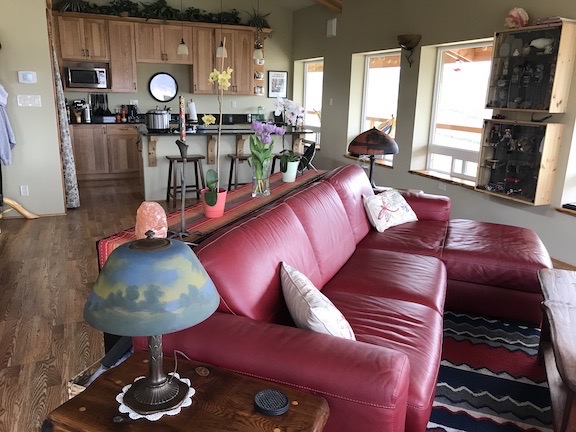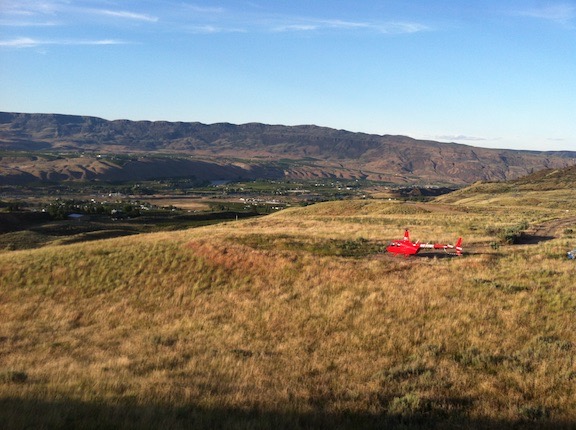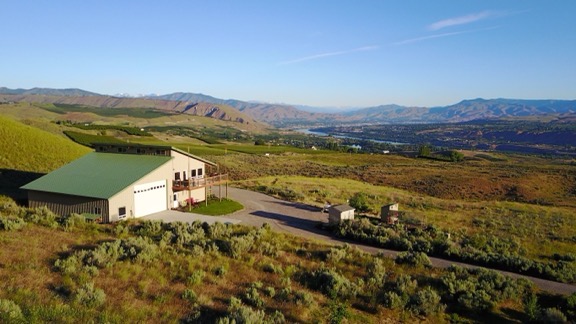I believe a cruising lifestyle is the answer to my current wanderlust needs.
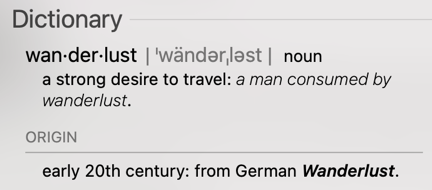
The dictionary defines Wanderlust as a strong desire to travel. That sums it up perfectly.
I’ve suffered from Wanderlust my entire life. I blame my grandfather.
Inherited Wanderlust
My mother’s father had it bad, especially later in life when I knew him. Once he was retired to a life around his home, he used to do a lot of driving. I don’t know where he went, but I do remember him following us on vacation once. We were low budget vacationers and a typical family vacation would be a drive to a campground at a northeast US destination — we lived in northern New Jersey — where we’d set up camp and spend a week in The Great Outdoors. I don’t remember which trip we were on when my grandfather improbably turned up, hundreds of miles from home.
My dad, of course, had a case of Wanderlust, too. His case was a lot like mine in that it combined a need to travel and explore with a desire to do it in with a motor vehicle. (My family members were not fans of hiking or air travel; in fact, I probably do more hiking and air travel than my parents or siblings ever did.) When I was young, our family vacations took us up or down the Atlantic seaboard, from southern Maine to Virginia. Sometime along the way, my dad acquired the first of a handful of small motorboats for exploring the Hudson, East, and Harlem Rivers of the New York Metro area and toting along on family vacations to destinations with waterways. I can still remember the trip to Lake George in New York when a wheel came off the boat trailer and passed us on the highway, seriously delaying our arrival.

An unscheduled stop along the Columbia River near its mouth in 2018 gave me the opportunity to pick wild blackberries, which I enjoyed with my breakfast for the next few days.
For me, Wanderlust means exploring places I’ve never been before — and revisiting some of the places I have explored in the past and liked. I’ve done it in cars and on motorcycles and in helicopters and on boats. It usually starts with a map or a suggestion from someone else. A route is set down, plans and preparations are made, and a trip begins. But what makes my Wanderlust differ from most people I know is my need to change the plan and explore new things I take note of along the way. Driving with a plan of going from Point A to Point B and being led off the path by a sign pointing to a waterfall in a national forest or a date ranch in the middle of the desert or a hiking trail around a small mountain lake or a channel leading to a remote town known for good ice cream. Not having reservations so I don’t have to cancel reservations. Making it up as I go along. I can’t begin to describe the feeling I get when I discover a new place worth seeing, even if it’s just a nice place to have a picnic lunch.

Sometimes taking an unmarked trail through a coastal forest can put you on a private beach.
My Travels
I’ve dealt with my version of the Wanderlust my entire life. I’ve visited 49 of the 50 states — Minnesota eludes me — and a (rather disappointing) handful of international destinations, including Canada, Mexico, Costa Rica, and numerous Caribbean Islands. And a trip to Germany when I was in my teens — don’t forget that. I traveled extensively for business during the last job of my corporate life (Career #1) and even more for business at the start of my freelance life (Career #2). In between I took numerous vacations with my future wasband that involved travel, often piggybacking a vacation onto one of my business trips. While the business travel involved metro areas and business hotels, the vacation travel often involved rental cars, camping gear, and national parks. I’ve seen a lot of America — and not just typical tourist destinations.
Understand that I am not a fan of packaged tours. While I like the concept of cruise ships — a hotel where you unpack once and visit a different city every day? Sign me up! — I don’t like the floating cities cruise ships are or the typical cruise ship mentality of the other passengers. (How many people on the Alaska cruise had booked their low-deck inside cabin just so they could tell people they’d “done” an Alaska cruise? The same people who didn’t get off the boat at port cities because they didn’t want to spend any money.) I can’t see making a trip overseas for just a week — if you’re going to go to Europe or Asia or Australia, you should stay at least a month to make that travel time worthwhile, no?
My Wanderlust needs were severely frustrated for a time when I lived in Arizona with my future wasband. I was a freelancer who, between projects, had a lot of free time on my hands. My future wasband was tied to a 9 to 5 job that left only weekends available for travel. (In the end, he spent much of his limited vacation time traveling back east to visit his family.)

Following a sign to a ghost town near Beatty NV back 2005 gave me a chance to see this building in Rhyolite before it was fenced off to prevent further damage.
I did a lot of travel on my own in those days. I made three long distance helicopter trips in my Robinson R22 helicopter in the early 2000s: around the Grand Canyon airspace, to Eagle CO, and to Placerville CA. In 2005, I took a 19-day solo road trip through the western states in my little Honda S2000. One of my publishers sent me to its locations in Ventura CA and Colorado Springs CO to work for them and I’d usually turn that trip into a mini solo vacation. In 2008, I started traveling seasonally to Washington State (where I now live) to do the agricultural work I now rely on to make a living — I traveled more around the area then than I do now.
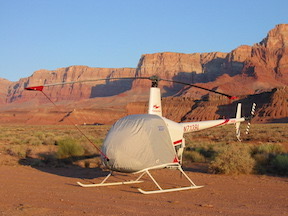

A trip around the Grand Canyon’s restricted airspace in the early 2000s in my R22 had me spending a night at Marble Canyon near Page AZ and remote Bar 10 Ranch 85 miles south of St George UT.
Getting divorced freed me to do more travel. I no longer had a whining, needy man child at home to hold me back. I visited family and friends all over the country. I did cruises. I did road trips. I enjoyed traveling more than ever.
But gradually, over time, I fell into a rut: stay at home all summer where I was on paid standby for my agricultural work and then travel south with my RV, usually to Arizona and California, to escape the winter dreariness of central Washington State. Sure, I did other trips once in a while, but I was definitely feeling the restraints of a routine — the one thing I just can’t tolerate in my life.
Cruising
I started thinking seriously about cruising — no, not the kind you do in huge floating cities — back in 2017 when I went to stay with a friend out at Lopez Island in the San Juan Islands of Washington. The trip didn’t go the way I’d hoped, but I discovered a lot about myself and other people and began to realize what I really wanted to do with my time: small boat cruising.
Of course, back then it was just an inkling of an idea. Since then I’ve done a lot of homework and taken a handful of trips. The homework taught me more about what was possible in a boat to cure my Wanderlust. I learned about the Great Loop, for example, which I saw as a lengthy exploration of waterways on the east coast without having to double back to a starting point.

Sunset from the dock at a state park marina in North Carolina, Spring 2022.
There’s something about being out on the water on a quiet morning, watching birds and water animals while the day is born. There’s something about motoring slowly up a channel, rounding a bend to see something unexpected, waving at other cruisers you pass, watching dolphins play in your wake. There’s something about pulling a trap full of crabs out of the water and cooking them for lunch, or catching a salmon you’ll have for dinner. There’s something about meeting other travelers for “docktails” in the evening at a marina and sharing stories about the places you’ve been and the people you’ve met along the water. There’s something about watching the sun sink down into the horizon, hearing the clanking of pulleys and creaking of boats against fenders when a gentle wave comes by from a passing boat.
The trips taught me other things:
- The 12-day Learn to Navigate the Inside Passage cruise with Northwest Navigation taught me all kinds of things about cruising slowly up the inside passage from Bellingham to Ketchikan: navigating waterways (of course), dealing with severe tidal currents, using autopilot and AIS, anchoring out, using tenders to reach shore, handling customs and immigration when crossing borders, etc, etc. I cannot say enough good things about this cruise and I hope to do it again one day, perhaps when my own cruising days have ended.
- A 5-week crew member gig on a 27′ Ranger Tug on the Great Loop from Jersey City NJ to Alpena MI showed me the Hudson River, Erie Canal, Lake Erie, and Lake Huron, with many points of interest along the way. I also learned how the Great Loop could be done at a quicker pace, with few stops longer than a day. It was also my first taste of marinas and public docks for overnight moorage and the challenges of ground transportation at destinations. And finally, I learned that not all adults act like adults — which is why I didn’t stay on board beyond Alpena when I was supposed to be on board three more weeks and depart in Chicago.
- A 5-week crew member gig on a 36′ Aft Cabin Carver on the Great Loop from Charleston SC to New Bern NC showed me how the Great Loop could be done in slow motion, with lengthy stops at marinas along the way. I learned a lot about navigating the Intracoastal Waterway (ICW), the kinds of conditions I could expect with its tides and inlets, and how pleasant it was to drive a boat from up on a fly bridge. It was just me and the captain on board and we got along well, but I have to admit that the slow pace we kept was agonizing to me — I was really hoping to see more and get farther along the Loop.
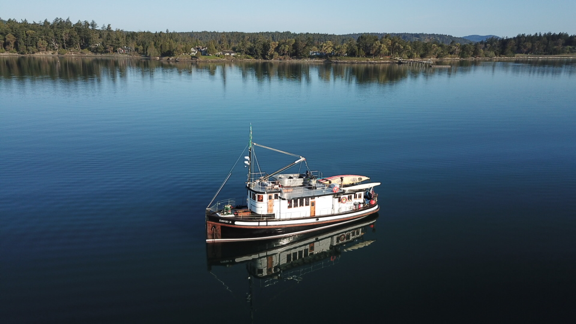
The David B at anchor in Garrison Bay. I was one of only four passengers on a 12-day trip in this 90-year-old wooden boat from Bellingham to Ketchikan.
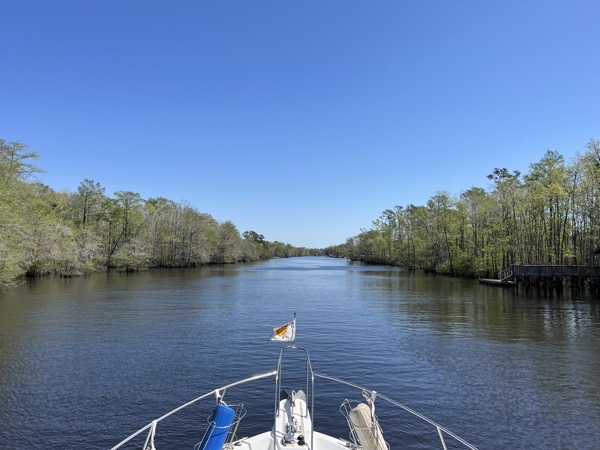
A stretch of the ICW from the flybridge on a 36′ Carver.
These three trips helped me come up with a plan for my own travels: spend two to three years cruising on the east coast, mostly along the Great Loop, and then bring the boat back to Washington to explore waterways closer to home: Lake Chelan, the Columbia and Snake Rivers, Puget Sound, the San Juan Islands, and the Inside Passage. By the time I’m done with all that, I should have the cruising thing worked out of my system — or be too old and crotchety to enjoy it.
Plans in Motion
To that end, I’ve begun making plans to acquire a suitable boat. After a lot of research, I’ve settled on a Ranger Tug R-29 CB, a 29′ tug/trawler style boat with a command bridge. The boat has all the features I need to handle something that size on my own — GPS navigation, auto pilot, fore and aft side thrusters, and command from indoor and outdoor stations — as well as the kind of amenities that will make cruising comfortable — full galley, head with shower, comfortable walk-around bed, accommodations for guests, large aft deck, solar panel. And did I mention the wine fridge?
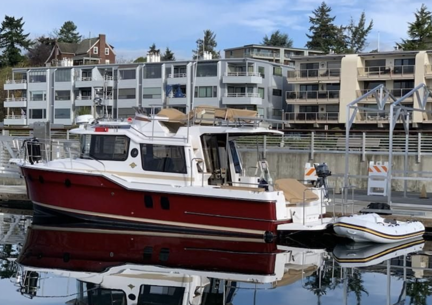
This is one of the boats currently available. I like its price and its low engine hours, but it’s missing a lot of little amenities that I need or want: a Bimini top for the command bridge, screen enclosure for the rear cockpit, generator, air conditioning, and trailer.
You can see a new version of the boat on the Ranger website. But no, I’m not buying a new one. (My budget is large, but not that large.) I’m looking at model years 2018 to 2021. The 2017 models have a Volvo D4 260 HP engine; Ranger went to the Valve D4 300 HP engine in 2018. Right now, there are 5 boats available and, as the market softens — mostly because of inflation and higher interest rates — I expect more boats to join them and prices to go down accordingly. The market was crazy tight back in the spring with boats selling nearly as quickly as they were listed.
(If you’re paying attention and have been reading my blog, you may recall my preference for 27′ Ranger Tug. I’ve gotten over that. After being on a 2017 R-27 with two other people last summer, I’ve decided that it’s simply too small. I know the R-29 sounds like it’s only 2 feet longer but it’s also 1 1/2 feet wider (8 1/2 foot beam vs 10 foot beam) and it has the command bridge space up top. Combined with that is the fact that the 2018 and later R-27s have an outboard motor, which limits living amenities such as hot water and battery charging. It’s designed as more of a day tripping or weekend boat than a serious cruising boat — something that was brought to my attention by the captain of the 2017 R-27 I was on last summer.)
I’m currently planning to make my purchase in September, so I’m trying hard not to dwell on the boats that are currently available; chances are, they’ll be gone when I’m ready to buy. I’ll spend the month of October getting it settled at a marina on the east coast, probably in Florida, where I hope to get some hands on training with a qualified instructor. Or, if I buy it in Washington, maybe I’ll get that training here in Puget Sound before having the boat moved to the east coast. This boat is trailerable and I do have a truck big enough to pull it. What I don’t have is a boat trailer big enough to carry it. I need to figure that — or the cost of having it moved — into the purchase price if I buy on the west coast and need to get it across the country.
The ultimate goal for this coming winter is to cruise long enough to get the experience days I need for my boat captain’s license. I’ll sit through a classroom course on the east coast, take (and pass!) the test, and submit all my paperwork to the Coast Guard. Then back home in spring for another summer of cherry drying standby service to earn a living. Then, in August, back to the boat and possibly take on paying passengers or crew members as I continue along the Loop. I’d love to spend August though October along the New York State and Canadian canal systems.
I’ve created a brand new Category (or Topic) for this blog: On the Water. That’s where you’ll find posts about my boating activities. As I write this, this is the only post there, but I’ll try to go back to previous blog posts related to boating and add them to this category.
And if you’re interested only in Great Loop related posts, I hope you’ll check out the My Great Loop Adventure blog. That’s where I share day-by-day accounts with photos of my travels on the Great Loop.
There’s more to report — like new relationships with publishers that will help me fund my travels — but I’d rather save that for when it becomes a reality. Right now, it’s just a solid lead with a great outlook.
Making It Happen
There’s a lot to juggle here but challenges in logistics that require thinking outside the box really appeal to me. So I’m treating it all like a challenge with a specific, well-thought-out goal. And I’m going through the steps to make it happen.
I hope you’ll come along for the ride. Maybe you’ll discover your Wanderlust, too.


